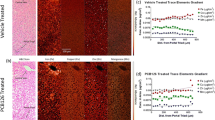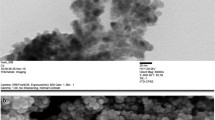Abstract
Endogeneous levels of zinc and copper were found to be 1.2±0.1×10−2 and 0.3±0.1×10−2 μg/A260 unit, respectively, in polysomal fractions from control animals; cadmium, however, was undetectable. In experimental animals (injected with cadmium) zinc, copper, and cadmium were found in polysomal fractions isolated by two different methods. One hour after a cadmium injection there was a rise in both the zinc and copper content of the polysomal fractions, which then declined steadily to below control levels by 16 h. Neither zinc nor cadmium were dialyzable from these fractions by a TRIS buffer; however, addition of 0.01M EDTA to the buffer resulted in removal of 75% of the zinc and all of the detectable cadmium.
The addition of cadmium (CdCl2) to control supernatants (adjusted to the cadmium concentration present in supernatants 6 h after in vivo exposure) resulted in metal binding to polysomal fractions in levels comparable to those observed after in vivo exposures to the metal. When cadmium was added in the form of cadmium thionein, a smaller fraction of the metal was isolated with the polysomal fraction. Cadmium bound to polysomal fractions in vivo (24 h after exposure) was sensitive to release by protease digestion, but insensitive to release by ribonuclease digestion.
Similar content being viewed by others
References
R. Brimacombe, G. Stoffler, and H. C. Wittman,Ann. Rev. Biochem. 48, 217 (1978).
I. G. Wool,Ann. Rev. Biochem. 48, 719 (1979).
R. A. Cox,Prog. Biophys. Molec. Biol. 32, 193 (1977).
M. Tal,Biochim. Biophys. Acta 169, 564 (1968).
R. D. Palmiter,Biochemistry 13, 3606 (1974).
D. S. Auld, H. Kawaguchi, D. M. Livingston, and B. L. Vallee,Proc. Natl. Acad. Sci. USA 71, 2091 (1974).
J. P. Slater, A. S. Mildvan, and L. A. Loeb,Biochem. Biophys. Res. Commun. 44, 37 (1971).
C. F. Springgate, A. S. Mildvan, R. Abramson, J. L. Engle, and L. A. Loeb,J. Biol. Chem. 248, 5987 (1973).
M. C. Scrutton, C. W. Wu, and D. A. Goldthwait,Proc. Natl. Acad. Sci. USA 68, 2497 (1971).
J. E. Coleman,Biochem. Biophys. Res. Commun. 60, 641 (1974).
K. H. Falchuk, B. Mazus, L. Ulpino, and B. L. Vallee,Biochemistry 15, 4468 (1976).
H. Lattke and U. Weser,FEBS Lett 65, 288 (1976).
R. Lohrman, P. K. Bridson, and L. E. Orgel,Science 208, 1464 (1980).
P. S. Kotsiopoulus and S. C. Mohr,Biochem. Biophys. Res. Commun. 67, 979 (1975).
S. Gamulin, N. Car, and P. Narancsik,Experientia 33, 1144 (1977).
B. L. Vallee and D. D. Ulmer,Ann. Rev. Biochem. 41, 91 (1972).
H. Hidalgo, V. Koppa, and S. E. Bryan,FEBS Lett. 64, 159 (1976).
N. Car, P. Narancsik, and S. Gamulin,Exptl. Cell Biol. 47, 250 (1979).
A. K. Falvey and T. Staehelin,J. Mol. Biol. 53, 1 (1970).
K. S. Squibb and R. J. Cousins,Biochem. Biophys. Res. Commun. 75, 806 (1977).
H. A. Hidalgo and S. E. Bryan,Toxicol. Appl. Pharm. 42, 319 (1977).
G. R. Schacterle and R. L. Pollack,Anal. Biochem. 51, 654 (1973).
I. San, R. Lin, and O. A. Schjeide,Anal. Biochem. 27, 473 (1969).
S. E. Bryan and H. Hidalgo,Bioch. Biophys. Res. Commun. 68, 858 (1976).
W. E. Wacker and B. L. Vallee,J. Biol. Chem. 234, 3257 (1959).
B. L. Vallee and W. E. Wacker, inThe Proteins, Vol V.Metalloproteins, Academic Press, New York, 1970, pp. 26–60.
S. G. Shapiro, K. S. Squibb, L. A. Markowitz, and R. J. Cousins,Biochem. J. 175, 833 (1978).
A. Lind, R. Villems, and M. Saarma,Eur. J. Biochem. 51, 529 (1975).
D. A. Brown and K. W. Chatel,Chem.-Biol. Interactions 22, 271 (1978).
C. Elinder and M. Piscator,Env. Health Perspect. 25, 129 (1978).
E. McGown, A. Richardson, L. M. Henderson, and P. B. Swan,Bioch. Biophys. Acta 247, 165 (1971).
H. Hidalgo and S. E. Bryan,Tox. Appl. Pharm. 42, 319 (1977).
Author information
Authors and Affiliations
Rights and permissions
About this article
Cite this article
Smith, H.A., Hidalgo, H.A. & Bryan, S.E. Heavy metal composition of polysomal fractions following cadmium challenge. Biol Trace Elem Res 4, 57–67 (1982). https://doi.org/10.1007/BF02789134
Received:
Accepted:
Issue Date:
DOI: https://doi.org/10.1007/BF02789134




